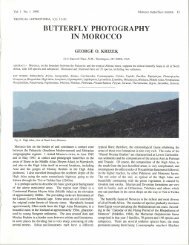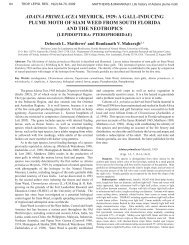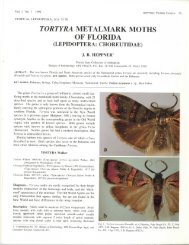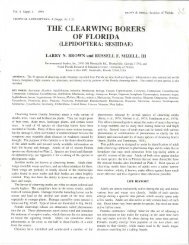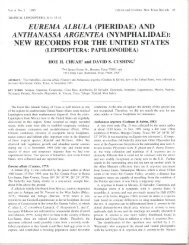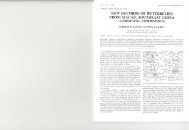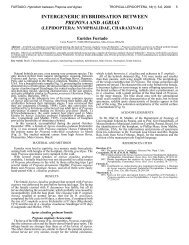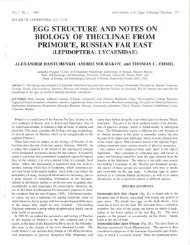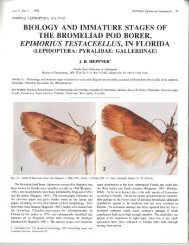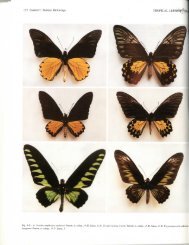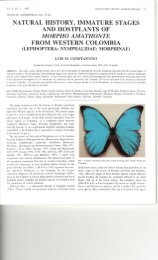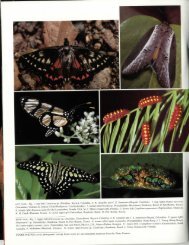THE REAL LARVA OF cASTNIA EudESmIA - Association for ...
THE REAL LARVA OF cASTNIA EudESmIA - Association for ...
THE REAL LARVA OF cASTNIA EudESmIA - Association for ...
Create successful ePaper yourself
Turn your PDF publications into a flip-book with our unique Google optimized e-Paper software.
56 TROP. LEPID. RES., 19(1):56-57, 2009ANGULO & OLIVARES: Real larva of Castnia eudesmiaSCIENTIFIC NOTE: <strong>THE</strong> <strong>REAL</strong> <strong>LARVA</strong> <strong>OF</strong> CASTNIA EUDESMIA(LEPIDOPTERA: CASTNIIDAE)Andres O. Angulo 1 and Tania S. Olivares 21Departamento de Zoología. Facultad de Ciencias Naturales y Oceanográficas, Universidad de Concepción. Casilla 160-C. Concepción, Chile. E-mail:aangulo@udec.cl; 2 Casilla 4040 correo 3. Concepción. Chile. E-mail: tolivare@udec.clAbstract. A description of the larval stage of the bromeliad base borer, Castnia eudesmia is provided. This paper corrects the previous description <strong>for</strong> this species,which mistakenly was based on a saturniid larva.Key words. Adetomeris erythrops, Bromeliaceae, chaetotaxy, Chile, larval morphology, Neotropical, Puya chilensis, Saturniidae, South America, OrmiscodesmarginataIn our previous paper related to this species (Angulo &Olivares, 1993), we erroneously described the immature stagesof Ormiscodes marginata Phil. (Saturniidae) under the nameCastnia psittacus (Molina, 1788). The latter moth speciesproved to be Castnia eudesmia Gray, 1838 (Miller, 1995).To correct our previous mistake, we now are describing thereal larvae of Castnia eudesmia Gray. The larvae of Castniaeudesmia bores into the creeping stems of its hostplant Puyachilensis (Bromeliaceae). Pupae appear in January with half ofthe pupae sticking out of the stem (Fig.2); adult emerges out ofthis exposed pupal case. C. eudesmia larvae of all instars can befound simultaneously.The hostlplant is heavily utilized by various Lepidopteralarvae. In addition to C. eudesmia, the floral stems are boredby larvae of Schistotheca canescens Ragonot (Pyralidae)(Angulo & Olivares, 2003); at the base and externally larvaeof Ormiscodes marginata Phil. (Saturniidae) can be found(Angulo & Olivares, 1993), and at the base of leaves feed thelarvae of Adetomeris erythrops (Saturniidae)Castnia eudesmia larvae were collected in January 1999at Hualpén and Ramuntcho (36º47’S 73º07’W), in the coastalenvironment shown in Fig. 1.Eggs were previously described by Angulo (1998).Larva (Figs. 3, 5-12): The larva is similar to a cerambycidbeetle larvae. The last instar larvae are 7.5 to 8.0 cm in length;body flattened dorso-ventrally. Young larva is reddish, turnigwhitish in the later instars; prothoracic shield is sclerotizedand dark brown (Fig. 3). Head is shiny and dark-brown; at thetop of the frontal triangle there is a lageni<strong>for</strong>m prominence(which might be used <strong>for</strong> breaking out of the pupal case); innerlabrum with 3 pairs of short setae and 3 pairs of very shortspicules; outer labrum with 6 pairs of long setae positioned intwo groups; mandibles are black, with 4 teeth (Fig.9), labiumis whitish with a long and uni<strong>for</strong>m spinneret with blunt apex(Fig. 8); prolegs are short with two rows of suboval crochetsand covered with short spines (Fig. 10); spiracle is light-brown;tubercles setigerous; three of the setae are creamy similar to 4and 5 all together situated down the spiracle; there are shortspines located dorsally, down the medial band .Fig. 1. Collecting locality and hostplant:the coastal habitat of Castnia eudesmiaat Ramuntcho, Hualpén, VIII Region,Chile, and the hostplant Puya chilensis(Bromeliaceae).Fig. 2: Pupal case sticking out ofthe creeping stem of its hostplant,Puya chilensis.ACKNOWLEDGEMENTSWe thank Direccion de Investigación, Project Nº 207.113.074-
ANGULO & OLIVARES: Real larva of Castnia eudesmiaTROP. LEPID. RES., 19(1):56-57, 2009 5739410Fig. 3-4. Life history of Castnia eudesmia: (2) Pupal case sticking out of the creepingstem of its hostplant, Puya chilensis; (3) Mature larva; (4) Frass appearing on thehostplant as a result of feeding.11125Fig. 9-12. Larval morphology of Castnia eudesmia: (9) mandibule; (10)Crochets; (11) ventral view of labrum; (12) dorsal view of labrum1.0, Universidad de Concepción, Concepción, Chile <strong>for</strong> thefinancial support.67Fig. 5-8. Larval morphology ofCastnia eudesmia: (5) Chaetotaxy;(6) Lateral view of cephalic capsulewith ocular area; (7) Front view ofcephalic capsule; (8) labium andhypopharingeal complex.8REFERENCES CITEDAngulo, A. O.1998. El huevo de Castnia psittacus Molina (Lepidoptera: Castniidae).Gayana Zoología 62 (2): 211-213.Angulo, A.O. and T. S. Olivares1993. Biology and immature stages of bromeliad base borer, Castniapsittacus, in Chile (Lepidoptera: Castniidae). Tropical Lepidoptera 4(2):133-138.2003. Biología y estados inmaduros del barrenador de la corteza,Schistotheca canescens, en Chile (Lepidoptera: Pyralidae: Galleriinae).Tropical Lepidoptera 11(1-2): 51-55.Miller, J.Y.1995. Castniidae, IN: Heppner (Ed.). Checklist, Atlas of NeotropicalLepidoptera. Asociation <strong>for</strong> Tropical Lepidoptera /Scient. Publ. Part 2:133-137, 176-177.



